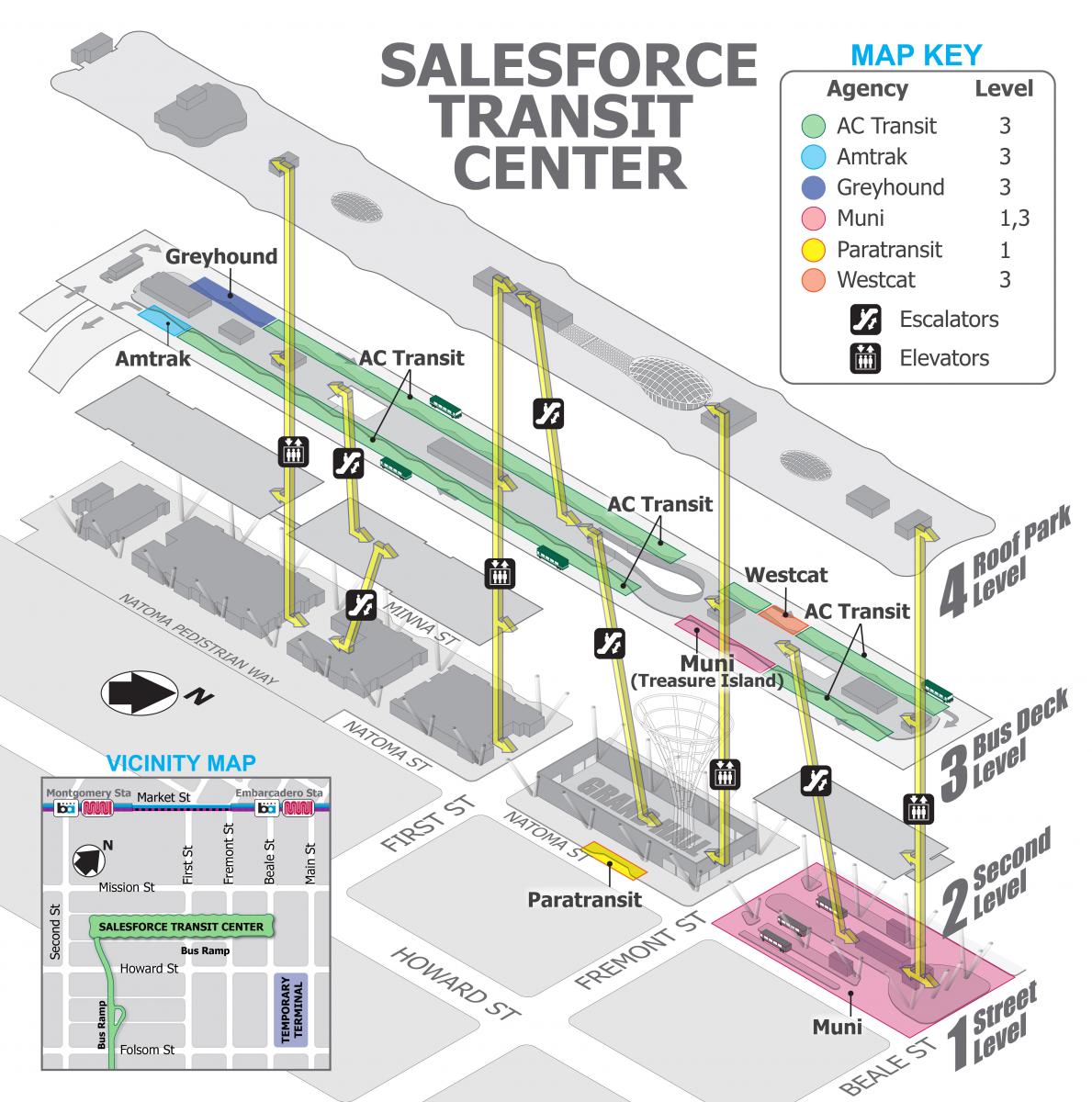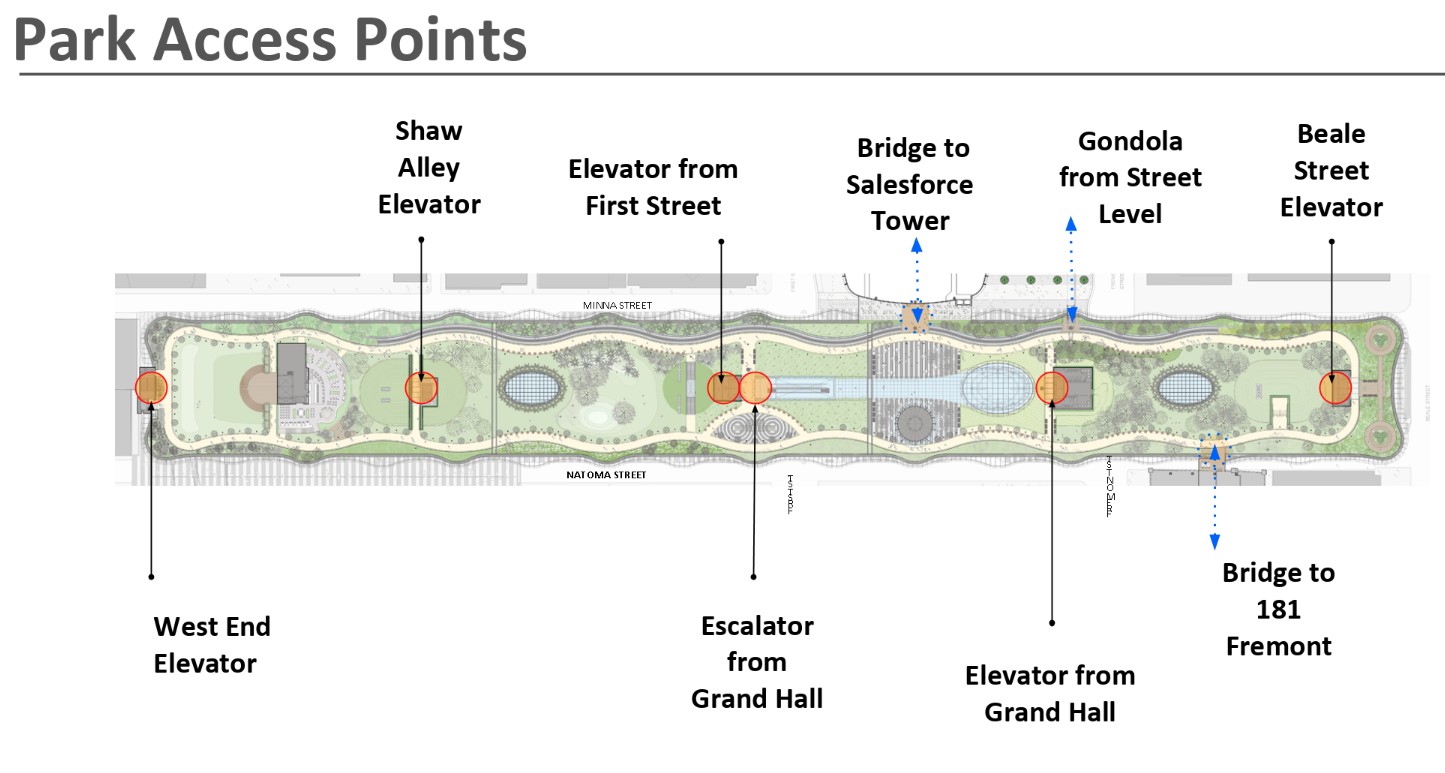Hello Everyone:
It is a lovely, almost winter, Monday afternoon and Yours Truly is ready for another week. The Candidate Forum wanted to remind everyone that Wednesday December 18, 2019, the House of Representatives will take a historic vote on the impeachment of Mr. Donald Trump. This has only been done twice before: Presidents Andrew Johnson and Bill Clinton were impeached but not removed from office. This is not something done lightly. The Candidate Forum will have its thoughts on Wednesday as well as a look toward the upcoming Senate trial. Until then, shall we chat about how a tech company is shaping public space.
| Salesforce Park San Francisco, California sf.curbed.com |
Salesforce Park is a "lush, five-and-a-half-acre rooftop arcadia of rolling meadows and meticulously landscaped, climatically harmonious, drought-tolerant flora" (newyorker.com; Dec. 11, 2019; date accessed Dec. 16, 2019). The verdant linear park in the middle of San Francisco, California, with a prehistoric garden and small wetland hydrated recycled water, rests on top of the Salesforce Transit Center, above Salesforce Plaza, and below Salesforce Tower. The Park is bordered by glass-fronted skyscraper office buildings and luxury condominiums. Salesforce Park features a "water sculpture" by Ned Kahn, titled Bus Fountain (Ibid), a dynamic water feature activated by the movement of buses in the terminal below. The amenities are available and clean. An idyllic place to spend a nice afternoon, like today, enjoying a break from the daily rush of activity.
| Mission Delores Park San Francisco, California sfrecpark.org |
California's second largest city is famous for its parks, beaches, secret gardens, and possibly the only city in the United States where a person can spend a day going from one ecosystem to another. San Francisco's green spaces also serve as dwelling place and Salesforce Park can feel like a alternate universe-"the Sky Club, not the gate" (Ibid), despite the designers and signage insisting that everyone is welcome. Underneath the Salesforce Transit Center is cavernous underground space that is currently empty, designated for a section of the California High-Speed Rail (Ibid; Feb. 15, 2019 ), which may or may not ever get built. This floating Eden is tax-payer funded and corporately branded floating above the homeless and acts a metaphor for the city's growing socioeconomic tensions. Anna Wiener writes, "It also feels like a bid, or a prayer, for a certain vision of the future" (Ibid; Dec. 11, 2019).
 |
| sfmta.com |
| Salesforce Transit Center retail salesforcetransitcenterretail.com |
In 2010, construction on the Transit Center began with the demolition of the nineteen-thirties era Transbay Terminal. The terminal was damaged by the earthquake and the ensuing seismic plan for the new building was so comprehensive that lead architect Fred Clarke predicted it would be probably one of the safest buildings in the world (Ibid). The new Transbay Terminal is a "bulbous, four-level structure, fourteen hundred feet long, wrapped in airy, rippling, perforate white metal, resembling, from a distance, a slightly flattened Noguchi lamp" (Ibid). The new building took about a decade to design and build, costing over two-billion dollars, requiring the city to help out with a quarter-billion-dollar municipal loan. It finally opened in 2018 as Salesforce Transit Center. Unfortunately, six weeks after the building it celebrated its opening ceremony, workers found cracks in two structural steel beams. The center was immediately shut down for repairs and quietly reopened this past July, returning to its role as a hub for regional and intercity public transit.
 |
| Going for a stroll in Salesforce Plaza Park hoodline.com |
Adam Greenspan, the landscape architect and one of the lead designers for the park explained to the New Yorker his concerns over public use of Salesforce Park. Mr. Greenspan said,
One of the concerns, early, was, are people going to go up?... Are people going to know that it's a public space? Are there going to be people around here? (Ibid)
People are aware that the park is open to the general public. Office workers from the surrounding towers are drawn to it for lunch, a meeting, or go for a run. Salesforce Tower and 181 Fremont--a luxury mixed-used building with commercial space leased by Facebook, have designated street entrances. Pedestrians can access the park using elevators, escalators, or gondola. Mr. Greenspan continued,
People really relax here, I've noticed,... But they also do a lot of work. People are working a lot, both having little walking meetings, but also sitting down by themselves and just typing (Ibid)
They also notice the plantings, making Adam Greenspan a very happy person.
 |
| sf.funcheap.com |
As Mr. Greenspan took the New Yorker on a tour of the park, he pointed out some of the three-dimensional signage on the park-level windows, affixed to the windows by tech companies like Slack, BlackRock, iShares, and Trulia. He observed,
At this point, certain tech companies and members of that community are becoming long-term makers of the city, and the region, and are committed to long-term relationships,... Salesforce, Facebook, Google--all of these places, I think, working to have more long-term physical impact that' looked at in a beneficial way. It's nice to see these groups as they have matured and are thinkin in a more established way, rather than just a startup, non-centered, digital kind of attitude toward places. (Ibid)
A playground and yoga classes against the backdrop of corporate logos. Today's class is sponsored by Facebook.
 |
| The Salesforce Park playground mtc.ca.gov |
Anna Wiener writes, "Parks, like cities, reflect their times" (Ibid). In 1982, architectural sociologist Galen Cranz published The Politics of Park Design (amazon.com; date accessed Dec. 16, 2019), an analysis of urban green spaces which identified four historical phases of city parks. Phase one is the "pleasure grounds" of the late 19th-century (sprawling pastorals on the city's outskirts), enjoyed by the middle class. The second phase were the "reform parks" of the early 20th-century (urban areas meant to engage idle children and encourage immigrant assimilation). By the mid-20th-century parks evolved into "recreation facilities," with athletic fields and courts for spectator sports, commonly in family-oriented suburbs. The fourth historical park phase is the "open-space system," more free-form spaces that encourage multiple uses by a broader range of urban dwellers. In 2004, Ms. Cranz and her co-author Michael Boland identified a fifth phase, "sustainable park," in the academic publication Landscape Journal. They suggested that the new form "was a respons to the anxieties of the late nineteen-sixties, when ecological crises were beginning to be understood as social concerns" (newyorker.com; Dec. 11, 2019)
 |
| Salesforce Park gondola 510families.com |
Recently, Ms. Cranz accompanied the New Yorker with her research assistant Chelsea Rushton on a tour of Salesforce Park, making observations on the abundance of children, the positions and sizes of benches. Ms. Rushton wondered if the spiky plants were meant as deterrent to homeless encampments. Short answer is probably yes. As the trio paused at the southern edge of the park, with of a view of the I-80 Freeway onramp, Ms. Cranz observed just how orchestrated the experience was--a sense of social control.
Indeed, when the trio exited the gondola, a Salesforce security guard, wearing a jacket identifying him as a Lobby Ambassador, approached Ms. Cranz and Rushton, causing Ms. Cranz to remark,
There's an issue of social control,... They don't want homeless, right? (Ibid)
Well, yes. Hence, the two San Francisco Police Department officers patrolling the park, filled with children, the spiky plants, and too short benches. Chelsea Rushton compared the experience to visiting the Sistine Chapel with its "rigidity of flow" (Ibid). Ms. Cranz elaborated,
You're threaded through---there's no choice,...You can't pause in front of one masterpiece. Here, you can pause, you can relax--but still, I feel a little bit like I'm an animal, like a cow being led through a maze, an eventually--... (Ibid)
She also likened the park to a ship,
It feels like being on a big ship,... You can't have complete freedom on a ship. You can't just wander around and fall off. It's not a replication of nature, in any nineteenth-century sense (Ibid)
Salesforce Park represented "open-space" iteration of urban parks. It takes advantage of urban opportunities, spatial opportunities, and say that a park isn't necessarily on land (Ibid).
Salesforce Park is not the familiar concept of an urban, rather, it is product of the tech industry. Like the type of advertising and news we see on our screens, the park is a creature of algorithms, a series of program elements of what people want in a park, including not encountering homeless encampments. It is understandable that park users want a clean and safe place to recreate or participate in athletic activities. However, if a park, like Saleforce Park, is truly meant to be a place for the people, it should be more free-form in the sense that it should include those unpredictable elements that make parks the beloved community institution they are.
No comments:
Post a Comment